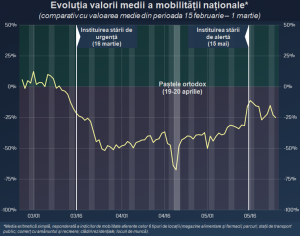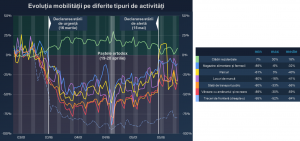Researchers at the Faculty of Economics and Business Administration (FSEGA) at Babeș-Bolyai University (UBB) of Kolozsvár/Cluj Napoca analyzed the evolution of mobility of Romania’s population during the state of emergency imposed due to the coronavirus pandemic. The work was part of the research project COVID-19 Romanian Economic Impact Monitor (COVID-19 RoEIM).
Using Google Mobility data for the period between March 16 and May 15, 2020, the researchers developed a national mobility index based on the movement of anyone with a Google account, using their location history. The research project was coordinated by university professor Dr. Levente Szász, the provost responsible for scientific research within the Faculty of Economics and Business Administration.
The results of the research show that the general reduction of mobility started 10 days before the establishment of the state of emergency, hitting a low of -52% compared to the average value of mobility on a national level in the period between February 15 and March 1, 2020. The minimum absolute record was registered during Easter when the mobility of the Romanian population was -67% compared to the same reference period. The average value for the entire period of the state of emergency was -41%.

The most important decreases in mobility were registered in merchandise trade and recreation activities (average value of -59%) and also those related to public transportation (average value of -56%). The most important growth immediately after the period of the state of emergency was registered in activities related to parks and green areas (May 14: -24%, May 15: +3%, May 16: +13%. During the same time, according to data from the Romanian Border Police, border crossings decreased an average of 84% compared to the same period last year.

Regarding the differences between counties, the UBB researchers realized that during the state of emergency, the most significant decrease was registered in Bucharest (average value of -52%), Brașov (-47%) and Cluj (-47%), all of which were below the national average of -41%.
In the same period, the smallest average decreases were registered in Giurgiu (-22%), Teleorman (-22%) and Călărași (-28%) counties with figures much higher than the national average value. During the period of the state of emergency, these “top” lists showed small variations, the counties with the greatest decreases being Iași and Ialomița.
The results of the research project can be seen on the COVID-19 RoEIM platform (econ.ubbcluj.ro/coronavirus), and a detailed analysis is continuously published on the project’s Facebook page. (https://www.facebook.com/covid19.roeim/).
Data and graphics: PR and Communication Directorate of UBB